Miroslav Pajic
RaGNNarok: A Light-Weight Graph Neural Network for Enhancing Radar Point Clouds on Unmanned Ground Vehicles
Jul 01, 2025Abstract:Low-cost indoor mobile robots have gained popularity with the increasing adoption of automation in homes and commercial spaces. However, existing lidar and camera-based solutions have limitations such as poor performance in visually obscured environments, high computational overhead for data processing, and high costs for lidars. In contrast, mmWave radar sensors offer a cost-effective and lightweight alternative, providing accurate ranging regardless of visibility. However, existing radar-based localization suffers from sparse point cloud generation, noise, and false detections. Thus, in this work, we introduce RaGNNarok, a real-time, lightweight, and generalizable graph neural network (GNN)-based framework to enhance radar point clouds, even in complex and dynamic environments. With an inference time of just 7.3 ms on the low-cost Raspberry Pi 5, RaGNNarok runs efficiently even on such resource-constrained devices, requiring no additional computational resources. We evaluate its performance across key tasks, including localization, SLAM, and autonomous navigation, in three different environments. Our results demonstrate strong reliability and generalizability, making RaGNNarok a robust solution for low-cost indoor mobile robots.
Assured Autonomy with Neuro-Symbolic Perception
May 27, 2025Abstract:Many state-of-the-art AI models deployed in cyber-physical systems (CPS), while highly accurate, are simply pattern-matchers.~With limited security guarantees, there are concerns for their reliability in safety-critical and contested domains. To advance assured AI, we advocate for a paradigm shift that imbues data-driven perception models with symbolic structure, inspired by a human's ability to reason over low-level features and high-level context. We propose a neuro-symbolic paradigm for perception (NeuSPaPer) and illustrate how joint object detection and scene graph generation (SGG) yields deep scene understanding.~Powered by foundation models for offline knowledge extraction and specialized SGG algorithms for real-time deployment, we design a framework leveraging structured relational graphs that ensures the integrity of situational awareness in autonomy. Using physics-based simulators and real-world datasets, we demonstrate how SGG bridges the gap between low-level sensor perception and high-level reasoning, establishing a foundation for resilient, context-aware AI and advancing trusted autonomy in CPS.
MARS: Defending Unmanned Aerial Vehicles From Attacks on Inertial Sensors with Model-based Anomaly Detection and Recovery
May 02, 2025Abstract:Unmanned Aerial Vehicles (UAVs) rely on measurements from Inertial Measurement Units (IMUs) to maintain stable flight. However, IMUs are susceptible to physical attacks, including acoustic resonant and electromagnetic interference attacks, resulting in immediate UAV crashes. Consequently, we introduce a Model-based Anomaly detection and Recovery System (MARS) that enables UAVs to quickly detect adversarial attacks on inertial sensors and achieve dynamic flight recovery. MARS features an attack-resilient state estimator based on the Extended Kalman Filter, which incorporates position, velocity, heading, and rotor speed measurements to reconstruct accurate attitude and angular velocity information for UAV control. Moreover, a statistical anomaly detection system monitors IMU sensor data, raising a system-level alert if an attack is detected. Upon receiving the alert, a multi-stage dynamic flight recovery strategy suspends the ongoing mission, stabilizes the drone in a hovering condition, and then resumes tasks under the resilient control. Experimental results in PX4 software-in-the-loop environments as well as real-world MARS-PX4 autopilot-equipped drones demonstrate the superiority of our approach over existing IMU-defense frameworks, showcasing the ability of the UAVs to survive attacks and complete the missions.
Probabilistic Segmentation for Robust Field of View Estimation
Mar 10, 2025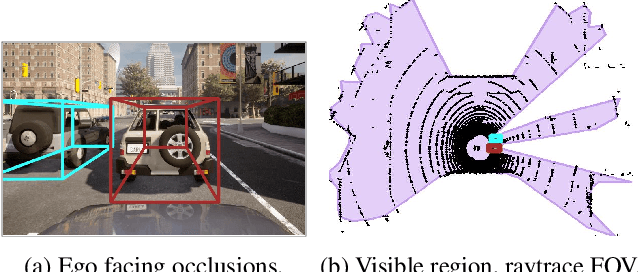
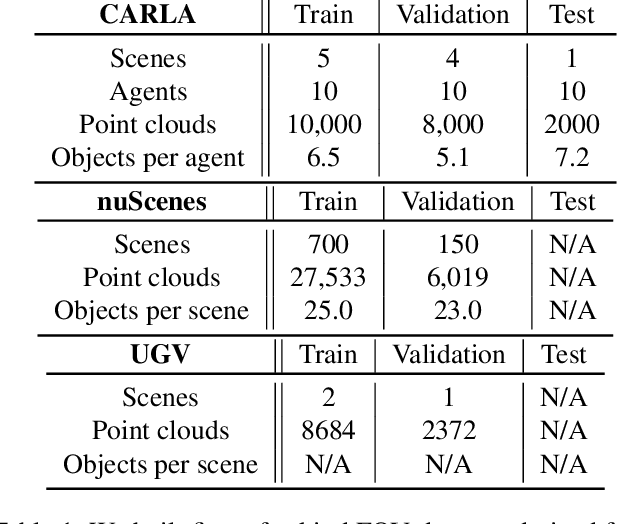
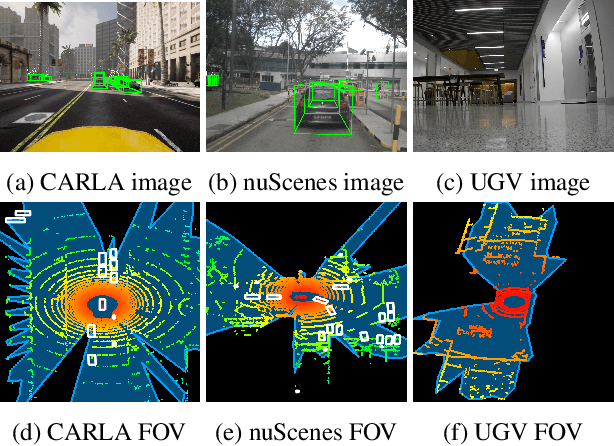
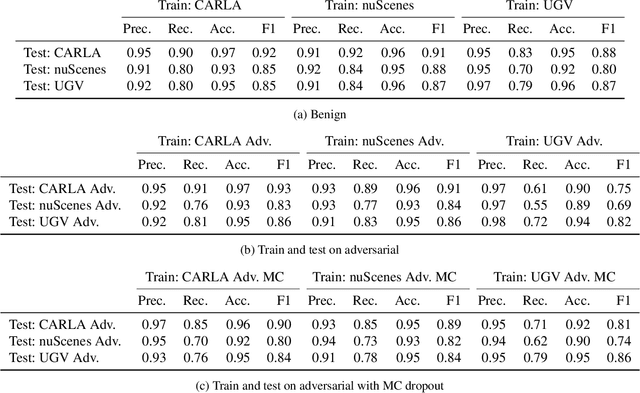
Abstract:Attacks on sensing and perception threaten the safe deployment of autonomous vehicles (AVs). Security-aware sensor fusion helps mitigate threats but requires accurate field of view (FOV) estimation which has not been evaluated autonomy. To address this gap, we adapt classical computer graphics algorithms to develop the first autonomy-relevant FOV estimators and create the first datasets with ground truth FOV labels. Unfortunately, we find that these approaches are themselves highly vulnerable to attacks on sensing. To improve robustness of FOV estimation against attacks, we propose a learning-based segmentation model that captures FOV features, integrates Monte Carlo dropout (MCD) for uncertainty quantification, and performs anomaly detection on confidence maps. We illustrate through comprehensive evaluations attack resistance and strong generalization across environments. Architecture trade studies demonstrate the model is feasible for real-time deployment in multiple applications.
NeuroStrata: Harnessing Neurosymbolic Paradigms for Improved Design, Testability, and Verifiability of Autonomous CPS
Feb 17, 2025


Abstract:Autonomous cyber-physical systems (CPSs) leverage AI for perception, planning, and control but face trust and safety certification challenges due to inherent uncertainties. The neurosymbolic paradigm replaces stochastic layers with interpretable symbolic AI, enabling determinism. While promising, challenges like multisensor fusion, adaptability, and verification remain. This paper introduces NeuroStrata, a neurosymbolic framework to enhance the testing and verification of autonomous CPS. We outline its key components, present early results, and detail future plans.
Off-Policy Selection for Initiating Human-Centric Experimental Design
Oct 26, 2024



Abstract:In human-centric tasks such as healthcare and education, the heterogeneity among patients and students necessitates personalized treatments and instructional interventions. While reinforcement learning (RL) has been utilized in those tasks, off-policy selection (OPS) is pivotal to close the loop by offline evaluating and selecting policies without online interactions, yet current OPS methods often overlook the heterogeneity among participants. Our work is centered on resolving a pivotal challenge in human-centric systems (HCSs): how to select a policy to deploy when a new participant joining the cohort, without having access to any prior offline data collected over the participant? We introduce First-Glance Off-Policy Selection (FPS), a novel approach that systematically addresses participant heterogeneity through sub-group segmentation and tailored OPS criteria to each sub-group. By grouping individuals with similar traits, FPS facilitates personalized policy selection aligned with unique characteristics of each participant or group of participants. FPS is evaluated via two important but challenging applications, intelligent tutoring systems and a healthcare application for sepsis treatment and intervention. FPS presents significant advancement in enhancing learning outcomes of students and in-hospital care outcomes.
Randomized Exploration in Cooperative Multi-Agent Reinforcement Learning
Apr 16, 2024
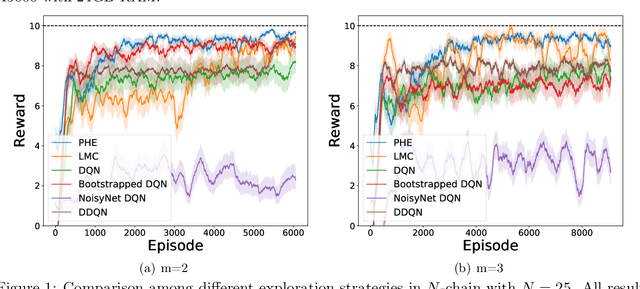
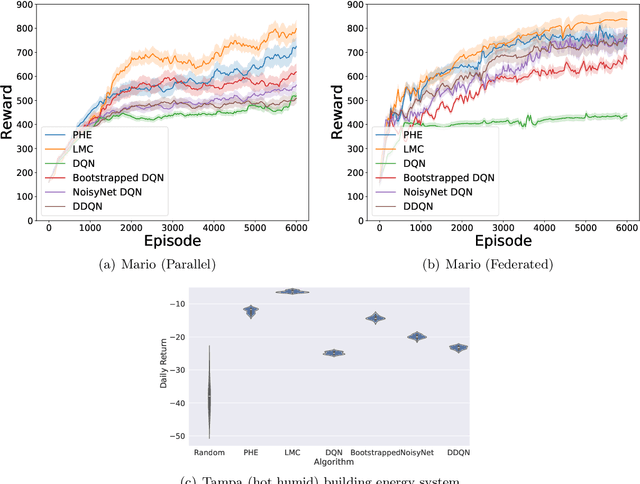

Abstract:We present the first study on provably efficient randomized exploration in cooperative multi-agent reinforcement learning (MARL). We propose a unified algorithm framework for randomized exploration in parallel Markov Decision Processes (MDPs), and two Thompson Sampling (TS)-type algorithms, CoopTS-PHE and CoopTS-LMC, incorporating the perturbed-history exploration (PHE) strategy and the Langevin Monte Carlo exploration (LMC) strategy respectively, which are flexible in design and easy to implement in practice. For a special class of parallel MDPs where the transition is (approximately) linear, we theoretically prove that both CoopTS-PHE and CoopTS-LMC achieve a $\widetilde{\mathcal{O}}(d^{3/2}H^2\sqrt{MK})$ regret bound with communication complexity $\widetilde{\mathcal{O}}(dHM^2)$, where $d$ is the feature dimension, $H$ is the horizon length, $M$ is the number of agents, and $K$ is the number of episodes. This is the first theoretical result for randomized exploration in cooperative MARL. We evaluate our proposed method on multiple parallel RL environments, including a deep exploration problem (\textit{i.e.,} $N$-chain), a video game, and a real-world problem in energy systems. Our experimental results support that our framework can achieve better performance, even under conditions of misspecified transition models. Additionally, we establish a connection between our unified framework and the practical application of federated learning.
On the Uniqueness of Solution for the Bellman Equation of LTL Objectives
Apr 07, 2024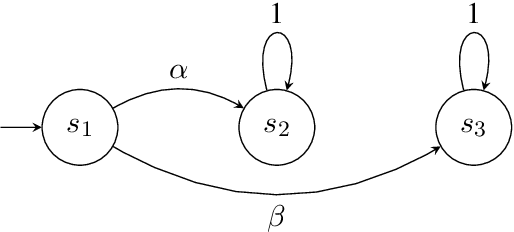
Abstract:Surrogate rewards for linear temporal logic (LTL) objectives are commonly utilized in planning problems for LTL objectives. In a widely-adopted surrogate reward approach, two discount factors are used to ensure that the expected return approximates the satisfaction probability of the LTL objective. The expected return then can be estimated by methods using the Bellman updates such as reinforcement learning. However, the uniqueness of the solution to the Bellman equation with two discount factors has not been explicitly discussed. We demonstrate with an example that when one of the discount factors is set to one, as allowed in many previous works, the Bellman equation may have multiple solutions, leading to inaccurate evaluation of the expected return. We then propose a condition for the Bellman equation to have the expected return as the unique solution, requiring the solutions for states inside a rejecting bottom strongly connected component (BSCC) to be 0. We prove this condition is sufficient by showing that the solutions for the states with discounting can be separated from those for the states without discounting under this condition
Bayesian Methods for Trust in Collaborative Multi-Agent Autonomy
Mar 25, 2024



Abstract:Multi-agent, collaborative sensor fusion is a vital component of a multi-national intelligence toolkit. In safety-critical and/or contested environments, adversaries may infiltrate and compromise a number of agents. We analyze state of the art multi-target tracking algorithms under this compromised agent threat model. We prove that the track existence probability test ("track score") is significantly vulnerable to even small numbers of adversaries. To add security awareness, we design a trust estimation framework using hierarchical Bayesian updating. Our framework builds beliefs of trust on tracks and agents by mapping sensor measurements to trust pseudomeasurements (PSMs) and incorporating prior trust beliefs in a Bayesian context. In case studies, our trust estimation algorithm accurately estimates the trustworthiness of tracks/agents, subject to observability limitations.
ε-Neural Thompson Sampling of Deep Brain Stimulation for Parkinson Disease Treatment
Mar 11, 2024



Abstract:Deep Brain Stimulation (DBS) stands as an effective intervention for alleviating the motor symptoms of Parkinson's disease (PD). Traditional commercial DBS devices are only able to deliver fixed-frequency periodic pulses to the basal ganglia (BG) regions of the brain, i.e., continuous DBS (cDBS). However, they in general suffer from energy inefficiency and side effects, such as speech impairment. Recent research has focused on adaptive DBS (aDBS) to resolve the limitations of cDBS. Specifically, reinforcement learning (RL) based approaches have been developed to adapt the frequencies of the stimuli in order to achieve both energy efficiency and treatment efficacy. However, RL approaches in general require significant amount of training data and computational resources, making it intractable to integrate RL policies into real-time embedded systems as needed in aDBS. In contrast, contextual multi-armed bandits (CMAB) in general lead to better sample efficiency compared to RL. In this study, we propose a CMAB solution for aDBS. Specifically, we define the context as the signals capturing irregular neuronal firing activities in the BG regions (i.e., beta-band power spectral density), while each arm signifies the (discretized) pulse frequency of the stimulation. Moreover, an {\epsilon}-exploring strategy is introduced on top of the classic Thompson sampling method, leading to an algorithm called {\epsilon}-Neural Thompson sampling ({\epsilon}-NeuralTS), such that the learned CMAB policy can better balance exploration and exploitation of the BG environment. The {\epsilon}-NeuralTS algorithm is evaluated using a computation BG model that captures the neuronal activities in PD patients' brains. The results show that our method outperforms both existing cDBS methods and CMAB baselines.
 Add to Chrome
Add to Chrome Add to Firefox
Add to Firefox Add to Edge
Add to Edge